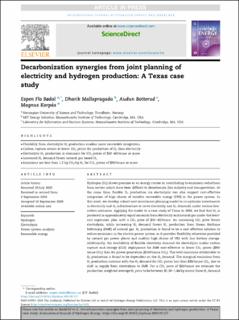| dc.contributor.author | Bødal, Espen Flo | |
| dc.contributor.author | Mallapragada, Dharik | |
| dc.contributor.author | Botterud, Audun | |
| dc.contributor.author | Korpås, Magnus | |
| dc.date.accessioned | 2020-11-02T14:09:49Z | |
| dc.date.available | 2020-11-02T14:09:49Z | |
| dc.date.created | 2020-10-30T13:49:26Z | |
| dc.date.issued | 2020 | |
| dc.identifier.issn | 0360-3199 | |
| dc.identifier.uri | https://hdl.handle.net/11250/2686093 | |
| dc.description.abstract | Hydrogen (H2) shows promise as an energy carrier in contributing to emissions reductions from sectors which have been difficult to decarbonize, like industry and transportation. At the same time, flexible H2 production via electrolysis can also support cost-effective integration of high shares of variable renewable energy (VRE) in the power system. In this work, we develop a least-cost investment planning model to co-optimize investments in electricity and H2 infrastructure to serve electricity and H2 demands under various lowcarbon scenarios. Applying the model to a case study of Texas in 2050, we find that H2 is produced in approximately equal amounts from electricity and natural gas under the leastcost expansion plan with a CO2 price of 30e60/tonne. An increasing CO2 price favors electrolysis, while increasing H2 demand favors H2 production from Steam Methane Reforming (SMR) of natural gas. H2 production is found to be a cost effective solution to reduce emissions in the electric power system as it provides flexibility otherwise provided by natural gas power plants and enables high shares of VRE with less battery storage. Additionally, the availability of flexible electricity demand via electrolysis makes carbon capture and storage (CCS) deployment for SMR cost-effective at lower CO2 prices ($90/ tonne CO2) than for power generation ($180/tonne CO2). The total emissions attributable to H2 production is found to be dependent on the H2 demand. The marginal emissions from H2 production increase with the H2 demand for CO2 prices less than 90/tonne CO2, due to shift in supply from electrolysis to SMR. For a CO2 price of $60/tonne we estimate t scenarios. These findings indicate the importance of joint planning of electricity and H2 infrastructure for cost-effective energy system decarbonization. | en_US |
| dc.language.iso | eng | en_US |
| dc.publisher | Elsevier | en_US |
| dc.relation.uri | https://www.sintef.no/prosjekter/hyper/ | |
| dc.rights | Navngivelse 4.0 Internasjonal | * |
| dc.rights.uri | http://creativecommons.org/licenses/by/4.0/deed.no | * |
| dc.subject | Energiplanlegging | en_US |
| dc.subject | Energy Planning | en_US |
| dc.subject | Bærekraftige energisystemer | en_US |
| dc.subject | Sustainable energy systems | en_US |
| dc.title | Decarbonization synergies from joint planning of electricity and hydrogen production: A Texas case study | en_US |
| dc.type | Peer reviewed | en_US |
| dc.type | Journal article | en_US |
| dc.description.version | publishedVersion | en_US |
| dc.subject.nsi | VDP::Elkraft: 542 | en_US |
| dc.subject.nsi | VDP::Electrical power engineering: 542 | en_US |
| dc.source.journal | International journal of hydrogen energy | en_US |
| dc.identifier.doi | https://doi.org/10.1016/j.ijhydene.2020.09.127 | |
| dc.identifier.cristin | 1843635 | |
| dc.relation.project | Norges forskningsråd: 255107 | en_US |
| dc.description.localcode | © 2020 The Author(s). Published by Elsevier Ltd on behalf of Hydrogen Energy Publications LLC. This is an open access article under the CC BY license (http://creativecommons.org/ licenses/by/4.0/). | en_US |
| cristin.ispublished | true | |
| cristin.fulltext | original | |
| cristin.qualitycode | 1 | |

